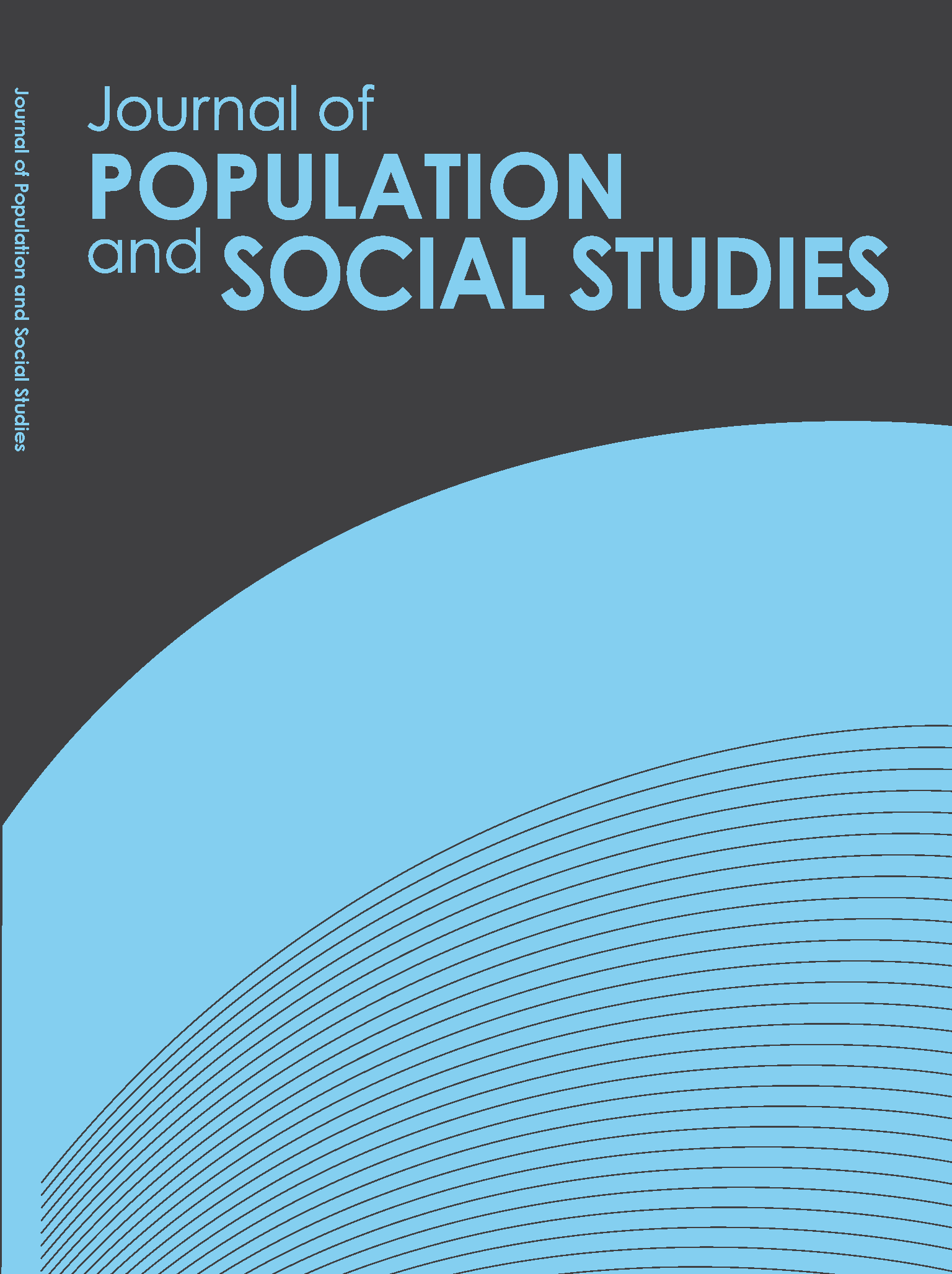Determinants of Childbearing among Thai-Muslim Generation Y in Thailand
Main Article Content
Abstract
The purpose of this study was to investigate the determinants of childbearing among Thai-Muslim Generation Y (those who were born between 1982 and 1997) in the southernmost provinces of Thailand. The data were collected from 1,200 respondents using structured questionnaires. A logistic regression analysis was used to analyze the relationship of various factors on childbearing. The findings revealed that the factors inducing an increase of childbearing were age, living in municipal area, having a household income of at least 30,000 baht, prospective job opportunities, family financial status, and feeling secure about having assistance in taking care of the children. And as much as these factors had a substantial bearing, the most salient factor on having children were cultural considerations. Conversely, the factors that decreased the opportunities of childbearing were being in common law marriages without legal marriage registration, having at least a secondary education, gaining adequate income, having access to contraception, the parents, company, and also being concerned about whether maternal leave with pay is possible. All of these have had a statistically significant relationship.
Article Details
References
• Asisonthisakul, R. (2006). เตรียมรับมือ Generation Y คลื่นลูกใหม่ขององค์กร [Prepare your organization for Generation Y]. Productivity World, 11(60) (January-February), 56-60.
• Chang, M.C. (2006). Taiwan’s transition from high fertility to lowest-low levels. Asian Journal of Health and Information Sciences, 1(1), 1-15.
• Davis, K., & Blake, J. (1956). Social structure and fertility: An analytic Framework. Economic Development and Cultural Change, 4(4), 211– 235.
• Fisher, A., Laing, J., & Stoeckel, J. (1983). Handbook for family planning operations research design. New York: The Population council.
• Hoem, B. (2000). Entry into motherhood in Sweden: the influence of economic factors on the rise and fall in fertility, 1986-1997. Demographic Research, 2(4), 177-212. doi:10.4054/DemRes.2000.2.4
• Jalovaara, M. (2013). Socioeconomic resources and the dissolution of cohabitations and marriages. European Journal of Population, 29 (2), 167-193. Retrieved from: https://www.jstor.org/stable/42636110
• Jitmoud, S. (1992). วัฒนธรรมอิสลาม [Islamic culture]. (3rd ed.). Bangkok: Thangnum.
• Kanchanachitra, M., Suttikasem, K., & Tadee, R. (2016). โครงการการส่งเสริมการมีบุตรผ่านการสร้างสมดุลระหว่างการทำงานและการสร้างครอบครัวที่มีคุณภาพ [Birth Promotion through Work-Life Balance and Quality of Family]. Bangkok: Strategic Research Issues (SRI) Unit and Institute for Population and Social Research, Mahidol University.
• Kanchanachitra, M., Tadee, R., & Suttikasem, K. (2017). การตัดสินใจด้านการเจริญพันธุ์ของคนเจนวาย [Generation Y and fertility decision]. In Thaweesit, S. & Vajanasara, K. (Eds.), ประชากรและสังคม 2560: ความเป็นธรรมและความเป็นไท ด้านเพศและการเจริญพันธุ์: ความท้าทายที่ไม่สิ้นสุด (pp.141-158). Nakorn Pathom: Institute for Population and Social Research, Mahidol University.
• Kravdal, Ø. (1994). The importance of economic activity, economic potential and economic resources for the timing of first births in Norway. Population studies, 48(2), 249-269. Retrieved from: https://doi.org/10.1080/0032472031000147786
• Laotaweesub, N. (2018). วางแผนมีบุตร กับการลดหย่อนภาษีปี'61 [Decision to have children and capital allowances in 2018]. Post Today. Retrieved from: https://www.posttoday.com/finance/money/544260
• Lesthaeghe, R. (1980). On the social control of human reproduction. Population and Development Review, 6(4), 527-548. doi: 10.2307/1972499
• Lesthaeghe, R., & Surkyn, J. (1988). Cultural dynamics and economic theories of fertility change. Population and Development Review, 14(1), 1-45.
• Liefbroer, A.C. (2005). The impact of perceived costs and rewards of childbearing on entry into parenthood: Evidence from a panel study. European Journal of Population, 21(4), 367-391. Retrieved from: https://link.springer.com/article/10.1007/s10680-005-2610-y
• Matsukura, R., Retherford, R.D., & Ogawa, N. (2007). Declining fertility in Japan: Its mechanisms and policy responses. Asian-Pacific Population Journal, 22(2), 33-50.
• Montgomery, M.R., & Casterline, J.B. (1996). Social learning, social influence, and new models of fertility. Population and Development Review, 22 (Supplement), 151-175. doi: 10.2307/2808010
• National Statistical Office of Thailand. (2016). Report on population characteristics; The 2015-2016 survey of population change. Bangkok: National Statistical Office, Ministry of Information and Communication Technology.
• National Statistical Office of Thailand. (2018). Demography population and housing statistics. Retrieved from: http://statbbi.nso.go.th/staticreport/page/sector/th/01.aspx
• Office of the National Economic and Social Development Board. (2013). การคาดประมาณประชากรของประเทศไทย 2553-2583 [Population Projections for Thailand 2010-2040]. Bangkok: October.
• Prasartkul, P. (2000). ประชากรศาสตร์: สารัตถศึกษาเรื่องประชากรมนุษย์ [Demography: Substantive study on human population]. Bangkok: Amarin.
• Prasartkul, P., & Vapattanawong, P. (2011). จุดเปลี่ยนประชากรประเทศไทย [Transitional point of the Thai population. In Punpuing, S., & Sunpuwan, M. (Eds), ประชากรและสังคม 2554: จุดเปลี่ยนประชากร จุดเปลี่ยนประเทศไทย (pp. 13-22). Nakhon Prathom: Institution for Population and Social Research, Mahidol University.
• Samutachak, B., & Darawuttimaprakorn, N. (2014). ไลฟสไตล์ แผนการดำเนินชีวิต กับแนวคิดการมีบุตรของคนเจเนอเรชันวาย [Lifestyle, life plans and the decision to have children among Generation Y]. In Vorasiriamorn, Y., Rittirong, J., Chuanwan, S., & Hunchangsith, P. (Eds). ประชากรและสังคม 2557: การเกิดกับความมั่นคงในประชากรและสังคม (pp. 213-232). Nakhon Prathom: Institution for Population and Social Research, Mahidol University.
• Samutachak, B., Konkaew, T., & Uden, R. (2017). ความอยู่ดีมีสุขของครอบครัวไทย [The well-being of Thai family]. Nakhon Prathom: Institution for Population and Social Research, Mahidol University.
• Smuseneto, A., Tongsamsi, K., Benrit, P., & Useng, N. (2017). เพศวิถีในชีวิตสมรสของชาวไทยมุสลิมจังหวัดปัตตานี [Sexuality in the marital life of Thai Muslims in Pattani province]. วารสารประวัติศาสตร์ ธรรมศาสตร์, 4(1) January-June, 270-322. Retrieved from: https://www.tci-thaijo.org/index.php/
thammasat history/article/view/92272
• Sobotka, T., Skirbekk, V., & Philipov, D. (2010). Economic recession and fertility in the developed world. Population and Development Review, 37(2), 267-306.
• Surkyn, J., & Lesthaeghe, R. (2004). Value orientations and the second demographic transition (SDT) in Northern, Western and Southern Europe: An update. Demographic Research, 3 (Special collection 3), 45-86. Retrieved from: https://www.demographic-research.org/special/3/3/s3-3.pdf
• Thaireform. (2016, April 13). คุยกับ ศ.ดร.เกื้อ วงศ์บุญสิน "ไทยกำลังเปลี่ยนจากสังคม DINK เป็น SINK" [Talk with Prof. Kua Wongboonsin, Ph.D. “Thailand is shifting from DINK to SINK societies”]. สำนักข่าวอิสรา. Retrieved from: https://www.isranews.org/thaireform/thaireform-slide/46213-dinks13.html


